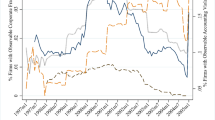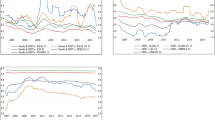Abstract
“If there were no losses; there would be no premiums,” Insurance proverb. This paper analyzes the history of natural catastrophe Insurance-Linked Securities (ILS), or Cat Bonds (CB), from 2001 to 2020. Preliminary analyses summarize the annual character of issuance during that period, providing context for the principal focus of the paper, which is losses. A detailed loss record is provided, including why and when losses occurred. This record, when set against the historic issuance, allows us to address several important questions, unaddressed in the literature but constantly posed by practitioners. Does the cumulative loss over 20 years equal what catastrophe models led to us expect? Were the relative sizes of actual losses reflective of expected losses? Most importantly, does the loss record support the idea that natural catastrophe models are accurate and useful? This paper is the first to specifically address these fundamental forensic questions against the loss record. It thereby makes an important contribution to the growing literature about ILS markets.










Similar content being viewed by others
Notes
Collateralized-re transactions, Industry Loss Warrantees [ILW]s, and Sidecars constitute the bulk of the other Alternative market instruments. They are not part of this study.
The terms Cat Bond and Nat Cat ILS are used interchangeably herein. The latter being the more modern practice.
Certain Mortgage, Auto securities, and Longevity swaps which embed insurance and/or residual value risk are sometimes considered part of the wider ILS market. They are not documented in this study.
It is implicitly assumed that the portfolio of ILS of different risks and perils stays fairly constant from year to year.
To be clear, the EL we are analyzing is the annual EL listed in the Offering Circular. Since different companies conduct the risk analysis for different securities, we are agnostic about the modeler. Since each modeler may remodel each other’s efforts a “remodeled EL” is often available to investors. That is not considered here. Similarly, “reset” requirements will often mean that a “reset EL” may be available to investors, post original issue date. Those too are not the ELs recorded herein.
A better acronym might be IBNFR—incurred but not fully reported, but instead we utilize the more familiar IBNR.
Secondary market price indications are usually on original issue limit. A convention is developing that when a partial loss payment has been made, price is subsequently quoted on the remaining limit. This creates problems for observers or analysts. The partial payment is not always public, different dealers adopt the remaining-limit practice at different times and some may not record the amount of the remaining-limit basis for their quote. This is a confusion that could be cured by standardization of practices and/or greater transparency.
The market estimate used herein is the midpoint between bid and ask quoted prices and further averaged over all available pricing sheets.
Astute readers will note that the average time on-risk is less than average term (2.04 years vs 3.3 years). This is because many of the recent issues will still be on-risk beyond the study horizon in this analysis (12/31/2020).
This measure, the PFL, can be a useful annual indicator of frequency. When multiplied by the number of deals outstanding in any year, it will give the number of ILS expected to be loss-affected that year.
Larger catastrophic losses existed in 2001 due to the terrorist attack on the World Trade Center. That loss was large but was “man-made,” not a natural catastrophe—the focus of this paper’s analysis.
Even if we randomly chose the eight years the ILS market experienced a loss, a simulation of results will display a distribution whose mean is close to $3,758 million.
The number 5.15% annually is an arithmetic average. Most independent industry return indices (Aon, Swiss Re and Lane Financial) are given in “compounded” equivalents, and over the twenty years in question hover around 6%. These two numbers are not inconsistent.
References
Altman, Edward I. 1968. Financial ratios, discriminant analysis, and the prediction of corporate bankruptcy. Journal of Finance 23: 589–609.
Altman, E. 1993. Defaulted bonds: Demand, supply, and performance 1987–1992. Financial Analysts Journal. 49 (3): 55–60.
Altman, E.I. 1998. The anatomy of the high yield bond market. Monograph September 21, 1998. NYU Stern School of Business.
Altman, E.I., and J. Swanson. 2007. The investment performance and market size of defaulted bonds and bank loans: 2006 review and 2007 outlook. Special Paper February 2007. NYU Stern School of Business.
Bantwal, V.J., and H.C. Kunreuther. 2000. A CAT bond premium puzzle? Journal of Psychology and Financial Markets 1 (1): 76–91.
Beer, S., and A. Braun. 2022. Market-consistent valuation of natural catastrophe risk. Journal of Banking and Finance 134: 106350.
Bodoff, N.M., and Y. Gan. 2009. An analysis of the market price of cat bonds. Casualty Actuarial Society E-forum, Spring.
Braun, A. 2011. Pricing catastrophe swaps: A contingent claims approach. Insurance, Mathematics and Economics 49 (3): 520–536.
Braun, A. Mueller, K and H. Schmeiser (2013) What drives Insurer’s Demand for Cat Bond Investments? Evidence from the Pan- European Survey. The Geneva Papers on Risk and Insurance – Issues and Practice. Vol. 38 (2013).
Braun, A. 2016. Pricing in the primary market for cat bonds—new empirical evidence. Journal of Risk and Insurance 83 (4): 811–847.
Braun, A., S.B. Ammar, and M. Eling. 2019. Asset pricing and extreme event risk: Common factors in ILS fund returns. Journal of Banking & Finance 102: 59–78.
Braun, A., M. Hermann, and M. Hibbeln. 2020. Common risk factors in the cross section of catastrophe bond returns. SSRN 3901695.
Duffie, D. 1998. Defaultable term structure models with fractional recovery of par. Working paper. Graduate School of Business, Stanford University.
Faias, J.A., and J. Guedes. 2020. The diffusion of complex securities: The case of CAT bonds. Insurance Mathematics and Economics 90: 46–57.
Galeotti, M., M. Gürtler, and C. Winkelvos. 2013. Accuracy of premium calculation models for cat bonds—an empirical analysis. The Journal of Risk and Insurance 80 (2): 401–421.
Giesecke, K., F.A. Longstaff, S. Schaefer, and I. Strebuaev. Corporate bond default risk: A 150 year Perspective. NBER Working Paper 15848, March 2010.
Hermann, M., and M.T. Hibbeln. 2020. Trading and liquidity in the catastrophe bond market, November 2020. SSRN 3530048.
Kreuser, J., and M.N. Lane. 2013. ILS market-derived metrics: Implications for risk adjustment transforms and capital allocations. In Alternative (re)insurance strategies, ed. M.N. Lane, 417–438. London: Risk Books.
Lane, M.N. 2000. Pricing risk transfer transactions. ASTIN Bulletin 30 (2): 259–293.
Lane, M.N. 2004. Arbitrage algebra and the price of multi-peril ILS. Journal of Risk Finance 5 (2): 45–51.
Lane, M.N. 2018a. One cost of global warming—a view from the ILS market. http://www.LaneFinancialLLC.com and Proceedings of the annual international accounting and finance conference (AF 2018), Singapore. SSRN 3260722.
Lane, M.N. 2018b. Pricing cat bonds: Regression and machine learning—some observations, some lessons. SSRN 3409350. http://www.LaneFinancialLLC.com.
Lane, M.N., and O. Mahul. 2008. Catastrophe risk pricing—an empirical analysis. Policy Research Working Paper, The World Bank (#4765).
Lee, J.-P., and M.-T. Yu. 2002. Pricing default-risky CAT bonds with moral hazard and basis risk. Journal of Risk and Insurance 69 (1): 25–44.
Major, J.A., and R.E. Kreps. 2002. Catastrophe risk pricing in the traditional market. In Alternative risk strategies, ed. M.N. Lane, 201–222. London: Risk Books.
Papachristou, D. 2009. Statistical analysis of the spreads of catastrophe bonds at the time of issue. Working Paper, Presented at the 39th ASTIN Colloquium.
Sterge, A.J., and B. Van der Stichele. 2016. Understanding cat bonds. The Journal of Alternative Investments 19 (1): 27–40.
General References
AIR Worldwide. 2020. (Multiple papers). http://www.air-worldwide.com/insights/articles.
AON Benfield. Insurance-Linked Securities—Research Reports (multiple years).
Swiss Re Institute. Insurance-Linked Securities and Sigma Reports (multiple years).
Acknowledgements
The materials gathered herein benefit from the information consistently provided from Aon Securities, Guy Carpenter and at times from Goldman Sachs, Swiss Re Capital Markets, and other colleagues and providers. Model analysis benefits from materials provided courtesy of AIR Worldwide.
Author information
Authors and Affiliations
Corresponding author
Additional information
Publisher's Note
Springer Nature remains neutral with regard to jurisdictional claims in published maps and institutional affiliations.
Rights and permissions
Springer Nature or its licensor holds exclusive rights to this article under a publishing agreement with the author(s) or other rightsholder(s); author self-archiving of the accepted manuscript version of this article is solely governed by the terms of such publishing agreement and applicable law.
About this article
Cite this article
Lane, M. The ILS loss experience: natural catastrophe issues 2001–2020. Geneva Pap Risk Insur Issues Pract 49, 97–137 (2024). https://doi.org/10.1057/s41288-022-00275-5
Received:
Accepted:
Published:
Issue Date:
DOI: https://doi.org/10.1057/s41288-022-00275-5




